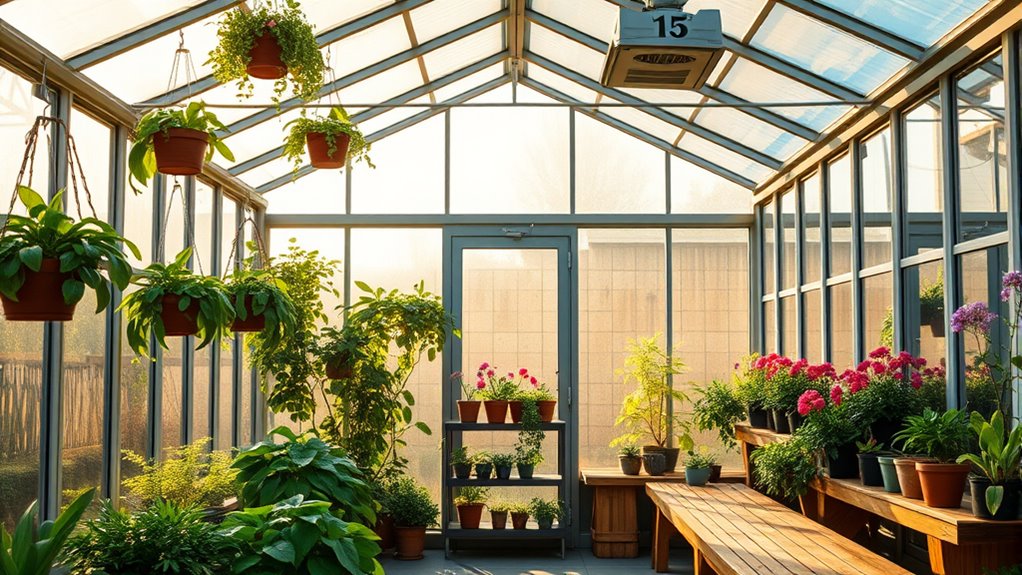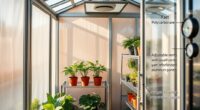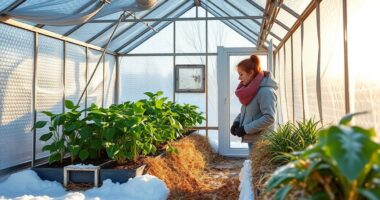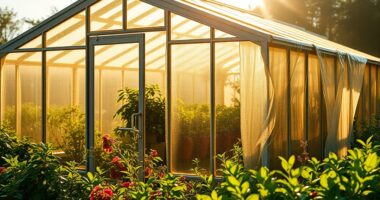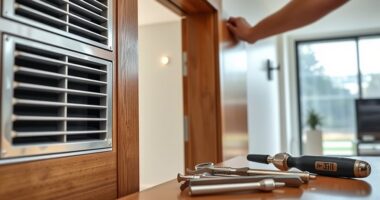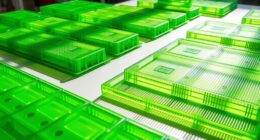When customizing your greenhouse, focus on creating a functional layout with wide pathways and adjustable storage to maximize space and accessibility. Choose durable materials like galvanized steel or treated wood, and optimize natural light with large south-facing windows. Incorporate effective ventilation, climate controls, and smart watering systems to guarantee healthy plants year-round. Add personal touches with decorative elements, and plan for seasonal adjustments. Keep exploring tips and ideas to design a space that’s both efficient and inspiring.
Key Takeaways
- Maximize space with adjustable shelving, vertical storage, and multi-purpose zones for efficient plant care and organization.
- Prioritize natural sunlight through strategic placement and large south-facing windows, supplemented by adjustable artificial lighting.
- Ensure pathways are at least 36 inches wide for easy access and implement ramps for accessible entry points.
- Use durable, weatherproof materials like galvanized steel or impact-resistant glazing to enhance longevity and climate control.
- Incorporate decorative elements such as artwork, sculptures, or themed fixtures to personalize and inspire your greenhouse space.
Selecting the Ideal Layout for Your Space

Choosing the right layout is essential for maximizing your greenhouse’s efficiency and plant health. Start by considering pathway arrangements that allow easy access to your plants without causing congestion. You want clear, wide pathways that facilitate movement and maintenance. Incorporate good lighting into your planning to ensure all areas are well-illuminated, promoting healthy plant growth. Zoning considerations are equally important; grouping plants with similar needs together helps optimize growing conditions and simplifies watering and care routines. Think about how sunlight will reach different areas and plan your zones accordingly. A well-organized layout minimizes unnecessary steps and reduces stress on plants. Additionally, understanding greenhouse design principles can help you create a functional and aesthetically pleasing space. Keep in mind, your space’s shape and size will influence your choices, so adapt your pathway and zoning plans to fit your specific greenhouse dimensions. Considering ventilation options can also improve airflow, reducing humidity and preventing diseases. Implementing self watering plant pots can further streamline your watering routines and improve plant health, especially in larger or more complex setups. A thoughtful layout boosts productivity and makes your gardening experience more enjoyable.
Incorporating Functional Storage Solutions
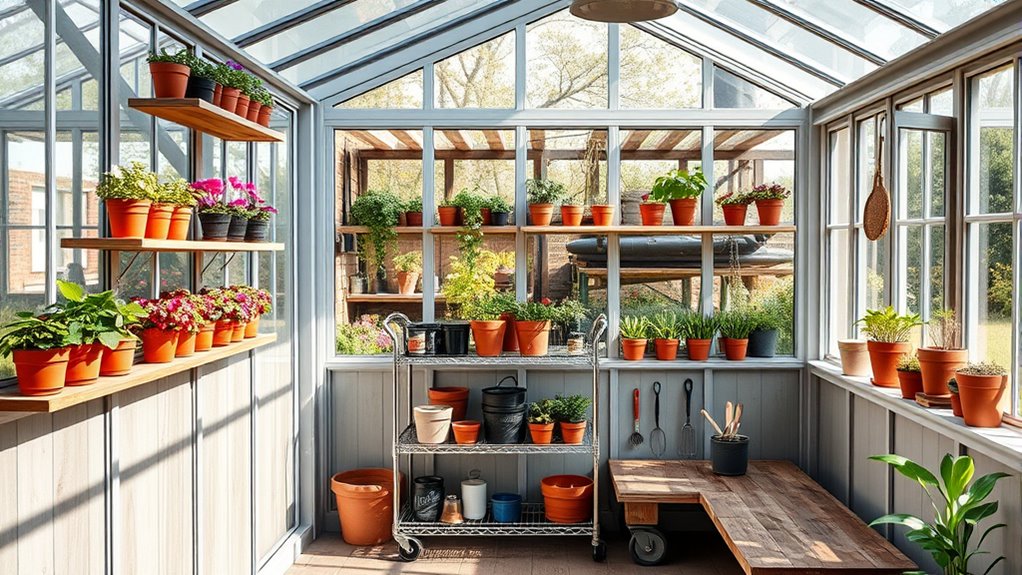
To keep your greenhouse organized, consider optimizing your shelving options for easy access to tools and supplies. Using multi-purpose containers helps maximize space and keeps everything tidy. These practical solutions make your greenhouse more efficient and enjoyable to work in. Incorporating vertical storage solutions similar to aftermarket modifications in vehicles can further enhance organization and functionality. Additionally, selecting storage options that are certified for safety and quality ensures long-term durability and protection for your supplies. Embracing exponential growth in eco-friendly materials can also contribute to a more sustainable and resilient storage system.
Optimizing Shelving Options
Maximizing the efficiency of your greenhouse often starts with optimizing shelving options to create functional storage solutions. Adjustable shelving allows you to customize space as your plant collection grows or changes, ensuring you can easily adapt to different plant sizes and needs. Incorporating lightweight racks is essential because they’re easy to move and rearrange, giving you flexibility as your setup evolves. Consider installing shelves at varying heights to maximize vertical space and improve accessibility. Use sturdy materials that resist humidity and rust, extending their lifespan. Keep frequently used tools and supplies within easy reach on open shelves, while less-needed items can be stored on higher or less accessible racks. Proper shelving organization can also help maintain a clean and efficient working environment, reducing clutter and making your greenhouse more enjoyable to work in. Additionally, implementing growth-focused storage strategies ensures that your shelving setup supports the healthy development of your plants while maintaining an organized workspace. Incorporating ventilated shelving units can improve airflow around your plants, promoting healthier growth and reducing the risk of mold or disease.
Using Multi-purpose Containers
Using multi-purpose containers can substantially streamline your greenhouse organization by combining storage and functionality in one solution. These containers are perfect for plant propagation, allowing you to store seed trays, labels, and tools all in one place. They also help with pest management by keeping soil, fertilizers, and plant debris contained, reducing pest attractants. You can use stackable bins for quick access to supplies while maintaining a tidy space. Additionally, selecting containers made from pest-resistant materials can further protect your plants and ensure a more resilient environment. Considering the material quality of containers can enhance their longevity and effectiveness, especially when exposed to moisture and soil. Using containers with moisture-resistant properties can prevent deterioration and extend their usability in humid greenhouse conditions. When choosing containers, considering their durability and material quality can enhance their longevity and effectiveness.
With the right multi-purpose storage solutions, you’ll simplify maintenance tasks and create a more organized, pest-free environment conducive to thriving plants.
Choosing the Right Materials and Finishes
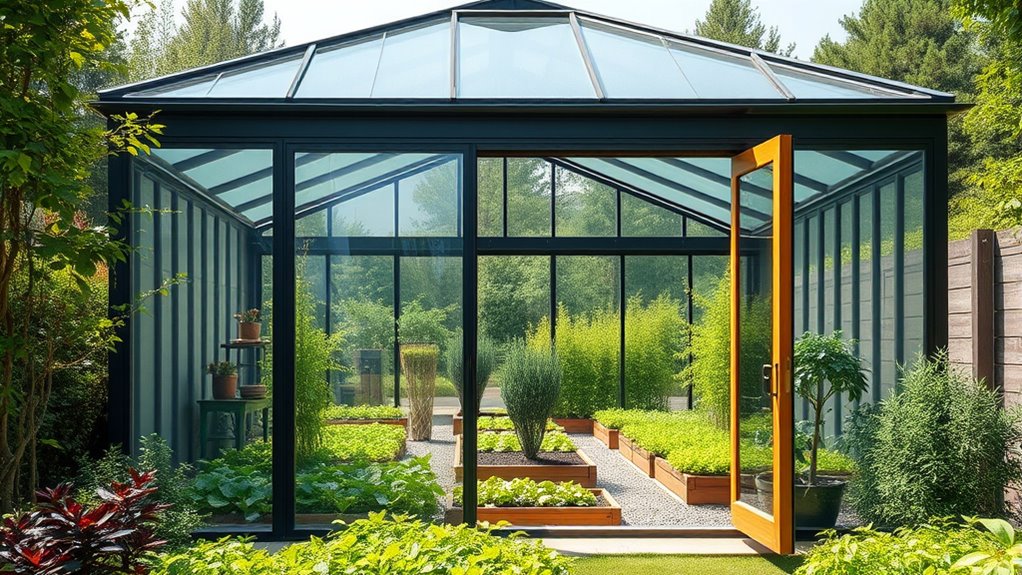
Choosing the right materials and finishes is crucial for creating a durable and efficient greenhouse. Material durability ensures your structure withstands weather, pests, and time, saving you maintenance costs in the long run. Using high-quality materials can significantly extend the lifespan of your greenhouse and reduce the need for frequent repairs. When selecting framing, options like aluminum or galvanized steel offer strength and corrosion resistance, while wood provides natural aesthetics if properly treated. For the glazing, consider polycarbonate panels for impact resistance and insulation or glass for clarity and finish aesthetics. Additionally, selecting appropriate finishes can prevent surface degradation and enhance overall appearance. Finishes also play an important role; a smooth, weatherproof coating enhances appearance and protects surfaces. Incorporating durability considerations into your choices can further ensure your greenhouse remains functional and attractive over time. Considering the climate conditions of your location can also influence your material choices, ensuring your greenhouse is well-adapted to local weather patterns.
Optimizing Lighting and Ventilation
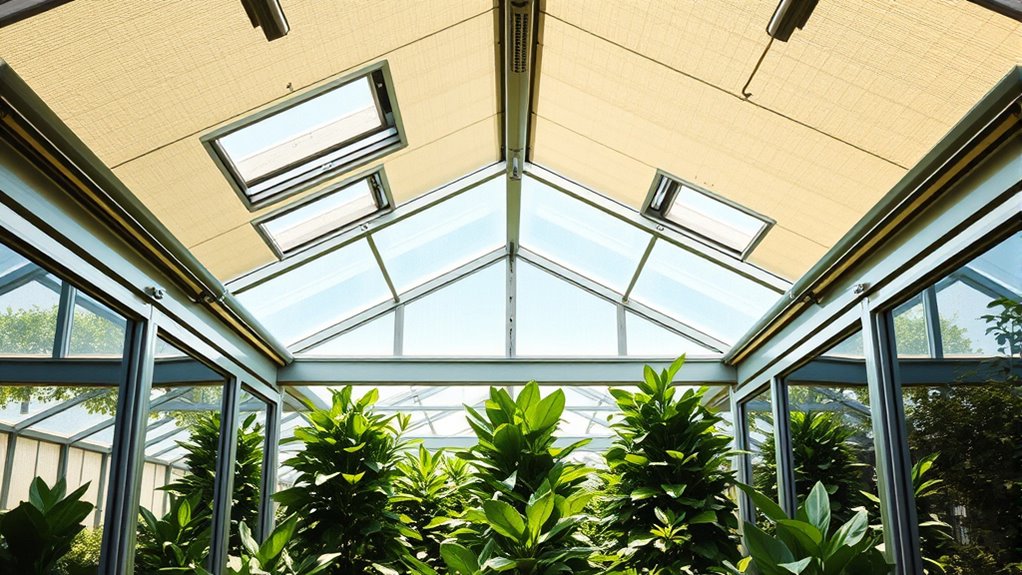
To grow healthy plants, you need to maximize natural light and guarantee proper airflow.
Implementing effective ventilation strategies helps prevent humidity buildup and keeps temperatures stable.
You might also consider supplemental lighting options to boost light during darker days or in shaded areas.
Maximizing Natural Light
Maximizing natural light in your greenhouse begins with strategic design choices that enhance sunlight penetration and promote airflow. Focus on solar orientation by positioning your greenhouse to face the sun’s path, typically south in the Northern Hemisphere, to capture maximum daylight throughout the day.
Proper window placement is essential; install large, adjustable windows on the south side to let in abundant light, and consider fewer openings on the shaded north side.
Use clear, UV-resistant glazing to maximize light transmission while protecting plants from harsh rays. Avoid clutter near windows that could block sunlight.
With careful planning of solar orientation and window placement, you’ll create a bright, well-lit environment that supports healthy plant growth and efficient energy use.
Effective Ventilation Strategies
Effective ventilation is key to maintaining a healthy greenhouse environment that supports ideal plant growth and efficient lighting. Proper airflow management prevents heat buildup, reduces humidity, and supplies fresh air.
To optimize ventilation, consider these strategies:
- Position your exhaust fan near the top of the greenhouse to expel hot, stale air effectively.
- Incorporate intake vents lower down to draw in cooler, fresh air, creating a natural airflow cycle.
- Use adjustable vents and fans to control airflow based on weather conditions and plant needs.
Supplemental Lighting Options
Have you considered how supplemental lighting can enhance your greenhouse environment? Grow lights are essential for extending daylight hours and supporting healthy plant growth, especially during winter months.
LED options are popular because they’re energy-efficient, produce less heat, and offer customizable spectrums tailored to specific plants. Installing grow lights at strategic heights ensures even light distribution, preventing weak or uneven growth.
You can choose from various LED options to match your plants’ needs, whether for seedlings, flowering, or fruiting. Incorporating supplemental lighting not only boosts productivity but also stabilizes your greenhouse climate, making it easier to control light levels year-round.
Properly selected and positioned grow lights can profoundly improve your greenhouse’s overall health and yield.
Adding Personal Style With Decorative Elements
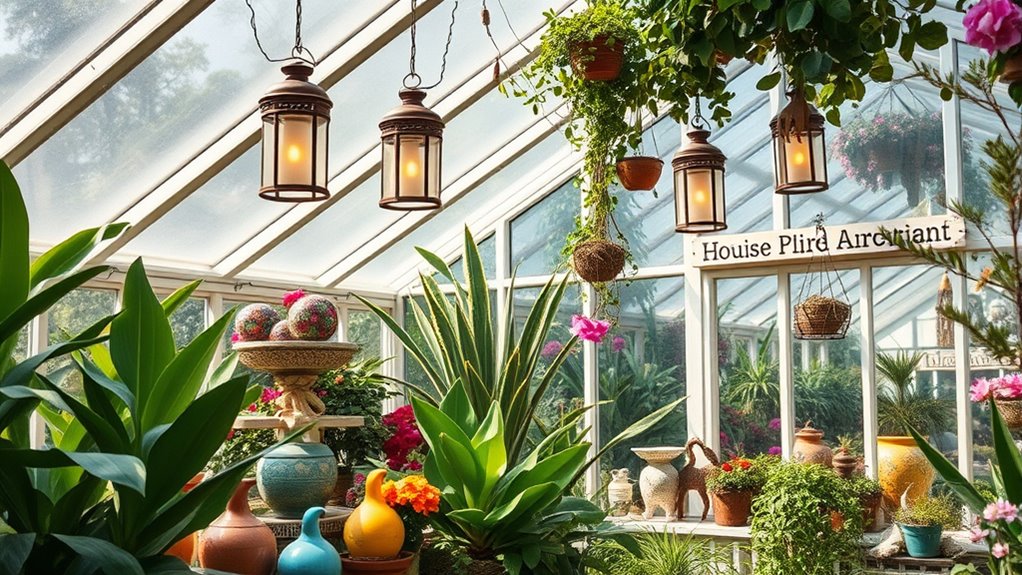
Adding personal style to your greenhouse can transform it from a simple structure into a reflection of your personality. You can achieve this by incorporating artistic accents and decorative fixtures that showcase your taste.
Here are some ideas to get started:
- Hang colorful or themed artwork on walls or windows to add visual interest.
- Use decorative fixtures like vintage lanterns or wrought iron plant hangers to create charm.
- Place unique sculptures or ceramic ornaments among your plants for a personal touch.
These elements not only enhance the aesthetic appeal but also make your greenhouse feel inviting and uniquely yours. Focus on items that resonate with your style and complement your plant display, creating a cozy, inspiring space.
Integrating Smart Technology for Automation
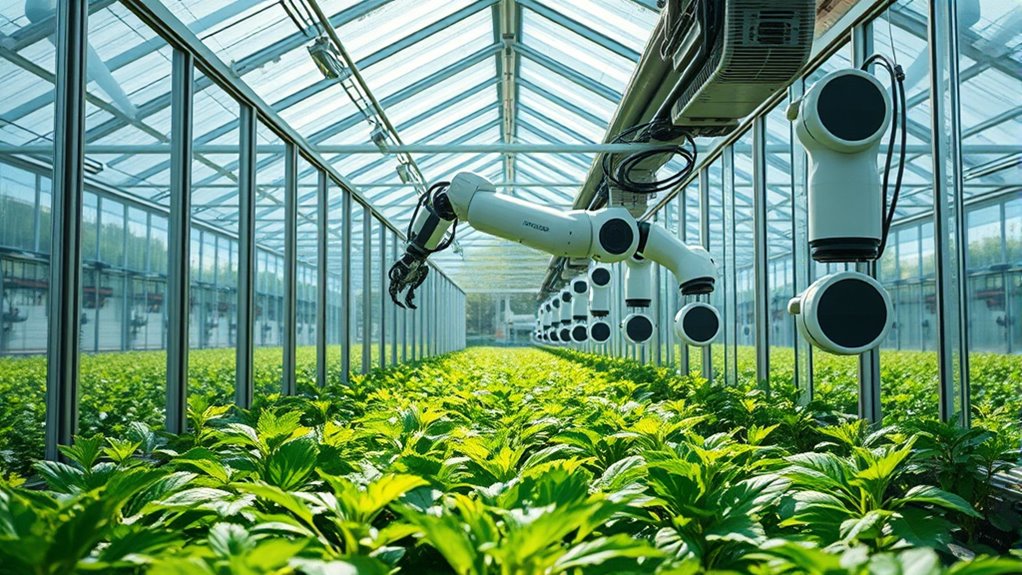
Incorporating smart technology into your greenhouse allows you to automate routine tasks and maintain ideal growing conditions with greater ease. With smart watering systems, you can ensure plants receive the right amount of water at the right times, reducing waste and preventing overwatering.
Automated climate controls help regulate temperature, humidity, and ventilation, creating an optimal environment regardless of external weather changes. By integrating sensors and connected devices, you gain real-time data to fine-tune conditions remotely.
Automated climate controls optimize temperature, humidity, and ventilation with real-time data for ideal plant growth.
This automation not only saves you time but also promotes healthier plant growth and higher yields. Whether you’re managing a small hobby greenhouse or a large commercial operation, smart technology simplifies complex tasks and enhances overall efficiency.
It’s a smart investment for a more productive, hassle-free gardening experience.
Creating Efficient Watering and Irrigation Systems
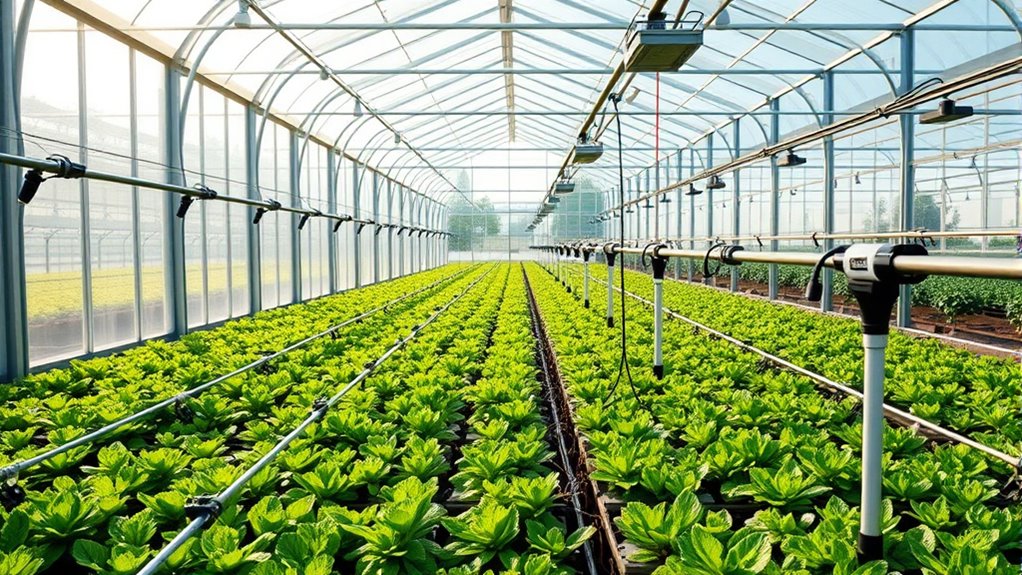
To guarantee your plants receive consistent and adequate moisture, designing an efficient watering and irrigation system is essential. A well-planned system conserves water and promotes healthy growth.
Consider these key strategies:
- Install drip irrigation to deliver water directly to roots, reducing waste and evaporation.
- Incorporate rainwater harvesting to collect and store rainwater, making your system more sustainable.
- Use timers and moisture sensors to automate watering, ensuring plants get the right amount without overwatering.
Designing for Seasonal Changes and Climate Control
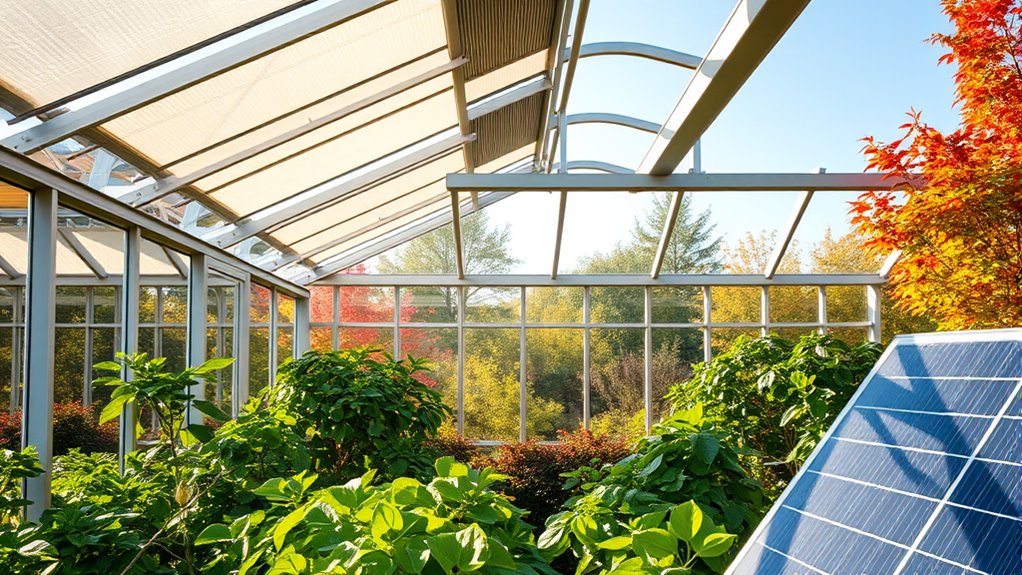
Since seasonal changes can profoundly impact your greenhouse environment, designing for these variations is crucial to maintaining ideal conditions year-round.
Implement climate adaptation strategies like adjustable vents, shading, and heating systems to regulate temperature and humidity effectively. Incorporate flexible features that support seasonal plant rotation, allowing you to swap crops based on sunlight and temperature needs.
Adapt your greenhouse with adjustable vents, shading, and heating to optimize temperature and humidity year-round.
Use insulation and thermal mass to stabilize indoor temperatures during extreme weather. Consider automated climate controls to respond quickly to changing conditions, reducing manual adjustments.
Proper planning ensures your greenhouse can withstand winter cold and summer heat, keeping your plants healthy and productive.
Planning for Accessibility and Ease of Maintenance
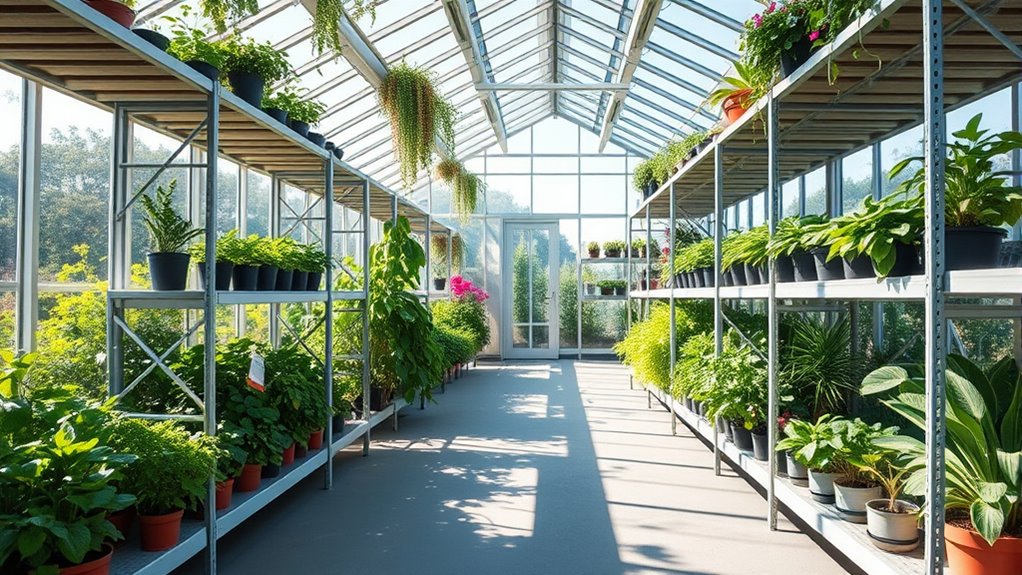
Designing your greenhouse with accessibility and ease of maintenance in mind guarantees you can care for your plants efficiently. Prioritize clear, wide maintenance pathways to prevent clutter and allow easy movement. Incorporate ramp accessibility at entry points to accommodate all users and reduce strain when transporting supplies.
Consider the placement of tools and watering stations within reach, minimizing unnecessary stretching or bending. Here are key tips:
- Ensure pathways are at least 36 inches wide for comfortable navigation.
- Install ramps where needed to provide smooth access over thresholds or uneven terrain.
- Arrange shelves and plant beds to keep frequently accessed areas within easy reach.
Frequently Asked Questions
How Can I Maximize Natural Light Inside My Greenhouse?
To maximize natural light inside your greenhouse, position it where sunlight hits most, like south-facing sites. Use transparent materials and keep windows clean for ideal light transmission.
Incorporate solar panel integration to harness sunlight efficiently and power automated ventilation systems, which help regulate temperature and humidity without blocking light. These strategies ensure your plants get ample sunlight, promoting healthy growth and a productive greenhouse environment.
What Are the Best Ways to Insulate My Greenhouse for Winter?
To insulate your greenhouse for winter, start by choosing the right insulation materials like bubble wrap, thermal blankets, or foam panels to trap heat effectively.
You should also explore winter heating options such as electric heaters, propane units, or heat mats to maintain a warm environment.
Proper sealing of vents and doors will prevent heat loss, ensuring your plants stay healthy and thrive despite the cold.
How Do I Choose Eco-Friendly and Sustainable Materials?
You might think eco-friendly materials aren’t durable, but investigations show recycled and biodegradable options can be just as sturdy.
When choosing, prioritize recycled plastics, reclaimed wood, and biodegradable films, which reduce waste and environmental impact.
By opting for these sustainable materials, you support a greener future and create a healthier space for your plants.
Trust that eco-conscious choices don’t compromise quality—they actively benefit both your greenhouse and the planet.
What Safety Features Should I Include in My Greenhouse Design?
You should prioritize safety by including proper ventilation systems to prevent mold and overheating, ensuring a healthy environment. Add security measures like sturdy locks and surveillance cameras to protect your plants and equipment. Incorporate fire extinguishers and first aid kits for emergencies.
Use tempered glass or polycarbonate panels for safety. These features keep your greenhouse secure, safe, and suitable for year-round gardening.
How Can I Customize My Greenhouse for Specific Plant Types?
To customize your greenhouse for specific plant types, focus on plant-specific shelving to accommodate different sizes and growth habits.
Incorporate humidity control strategies like misting systems or humidifiers for plants that thrive in high humidity.
Adjust lighting, ventilation, and temperature settings accordingly, and use targeted watering routines.
These steps help create an ideal environment, ensuring your plants flourish and stay healthy in your customized greenhouse setup.
Conclusion
By customizing your greenhouse with thoughtful design ideas, you create a vibrant, efficient space tailored to your needs. Did you know that properly optimized greenhouses can boost plant growth by up to 40%? Incorporate smart technology, clever storage, and personalized touches to maximize your space’s potential. With careful planning, your greenhouse becomes not just a functional area, but a beautiful sanctuary where your gardening dreams thrive.
